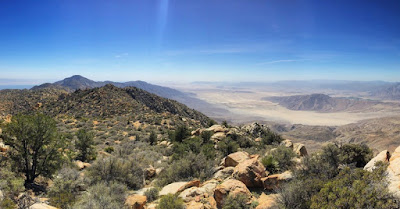52 Hike Challenge 2016 Adventure Series
14 miles | +6200'
(Photo credit: Don Endicott)
I can say without a doubt that this was the most difficult
hike I've ever done. Words fail to describe the feelings of accomplishment and
awe I experienced at the summit. My companions were Scott Turner (co-author of
the 5th edition to Afoot & Afield in San Diego County), and Don Endicott, a
former hiking companion of Jerry Schad.
Here is Don's write up:
Anza-Borrego Desert State Park and Santa Rosa Wilderness
Saturday, Sunday 26-27 March 2016
"One of the more strenuous hikes in the Anza-Borrego
Desert State Park area, Dawn’s Peak is situated half way between Toro Peak and
Rabbit Peak along the backbone of the Santa Rosa Mountains northeast of Borrego
Springs, California and southwest of Palms Springs, Indio, and the Coachella
Valley.
I previously hiked and mapped this entirely cross country
route back in April 2007 during a two day backpack with good friend Don Raether.
This year, I teamed with Scott Turner and his friend John Graham for a reprise
of that hike and to help Scott complete the last hike of his year-long effort
to co-author a new 5th Edition of Afoot & Afield in San Diego County, THE
San Diego hiker’s bible, originally written by my good friend and hiking and
running companion, Jerry Schad.
As was the case nine years ago, we packed in about four
miles from upper Clark Valley to spend the night, passing the Corp benchmark
and petroglyph site along the way. Based on experience, I carried 11 liters of
water, adding a hefty 24 pounds to the rest of my pack, contributing to a
relatively modest pace to scramble and rock hop through broken terrain to reach
camp in a side canyon at 2400 feet, a 4 mile, 1600 foot ascent. After dinner
and quiet conversation, Scott and John turned in and I stayed up a bit longer
to take in the exceptional night sky, including the constellations Canis Major,
Orion, and Taurus parading over the ridge to the southwest.
Next morning we arose early, packed our gear, donned
daypacks, and started hiking in predawn twilight a little after 6 am. The first
section is steep and rocky, ascending 1000 vertical feet to reach rolling bench
that leads to the base of Dawn’s Peak. The wildflowers were exceptional with
lush yellow Brittlebush seemingly everywhere. Brilliant magenta blossoms of
Hedgehog Cactus and Beavertail Cactus accented our route as did a variety of
smaller, ground level flowers.
The last mile to the summit follows the west ridge of Dawn’s
Peak and involves a climb of 3000 vertical feet of slip-and-slide hiking along
the backbone of decomposed granite and large boulder outcrops with agave and
cholla obstacles on the lower half and Pinyon and agave on the upper half. As
we topped out on the crest of the Santa Rosas, we met up with Robert Hunt,
another accomplished desert hiker and ultra-distance runner. Robert had trekked
in and up from Rockhouse Canyon by moonlight last night and celebrated Easter
Sunrise in the summit area. Although knowing of each other, this was the first
time we actually met Robert in person.
At the summit cairn, everyone took a turn signing into a
peak register that went back to the early 1980s that included Jerry Schad’s log
entry from February 1983. I left a copy of my celebration of life eulogy
originally given at Jerry’s memorial service in November 2011. I noted that our
hiking time up from camp was a decent 4 hours and 40 minutes, only 10 minutes
longer than in 2007 – not bad for someone now old enough to qualify for
Medicare.
Following lunch, Robert joined us for the hike out. Aside
from a hefty rock that came tumbling down to just miss Scott and 40 feet below
graze my pack as I hugged against an outcrop, our descent was uneventful. On
the way back to camp, I pointed out a village site I had discovered back in
2007. We also passed a large agave roasting pit, along with pottery sherds and
fragments of flake stone, further evidence of the many centuries of occupation
by the native Mountain Cahuilla.
After picking up our packs, we followed our original trail
in reverse, impressed with how far we had come and how much we had climbed.
Along the way a partial olla was discovered, admired, photographed, and
returned to its cubby hole. Back down at the Corp petroglyphs, we parted with
Robert who still had five miles to reach his car at the Hidden Spring
trailhead.
We arrived back at my 4Runner shortly before 7 pm with
handshakes and congratulations to Scott for completing this capstone trip and
finalizing the Afoot & Afield project."
TRIP SUMMARY
Total Distance: 14 miles round trip
Elevation Gain/Loss: 6200 feet
Hiking Time (Saturday, trailhead to overnight camp) – 3
hours
Hiking Time (Sunday, overnight camp to summit to trailhead)
– 11 hours 20 min






















































